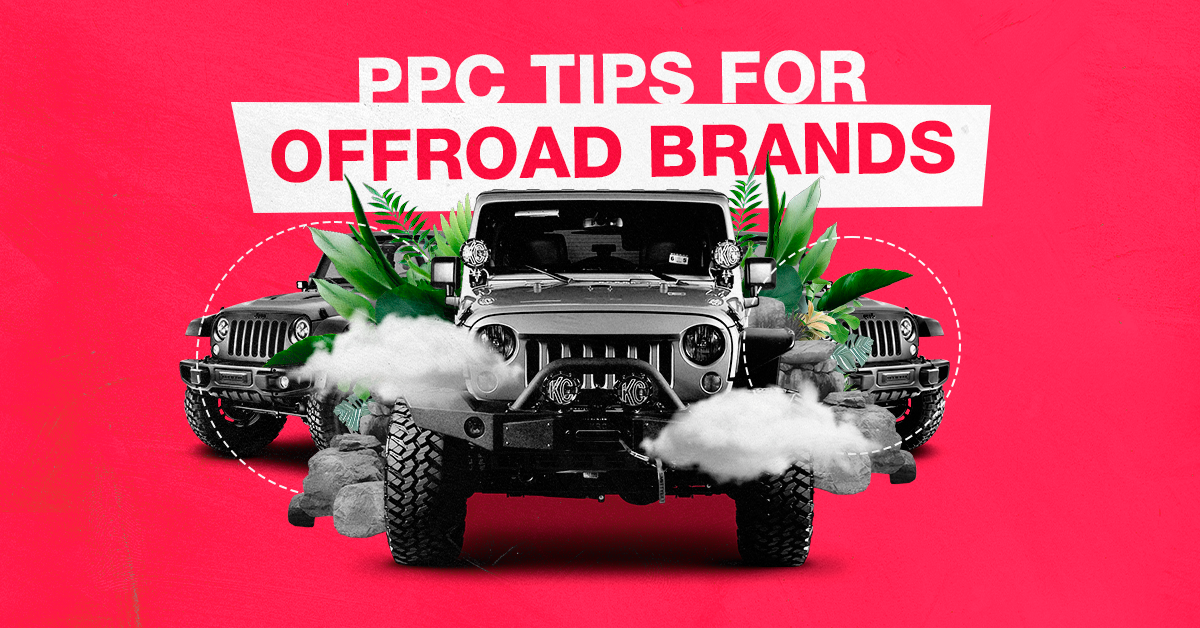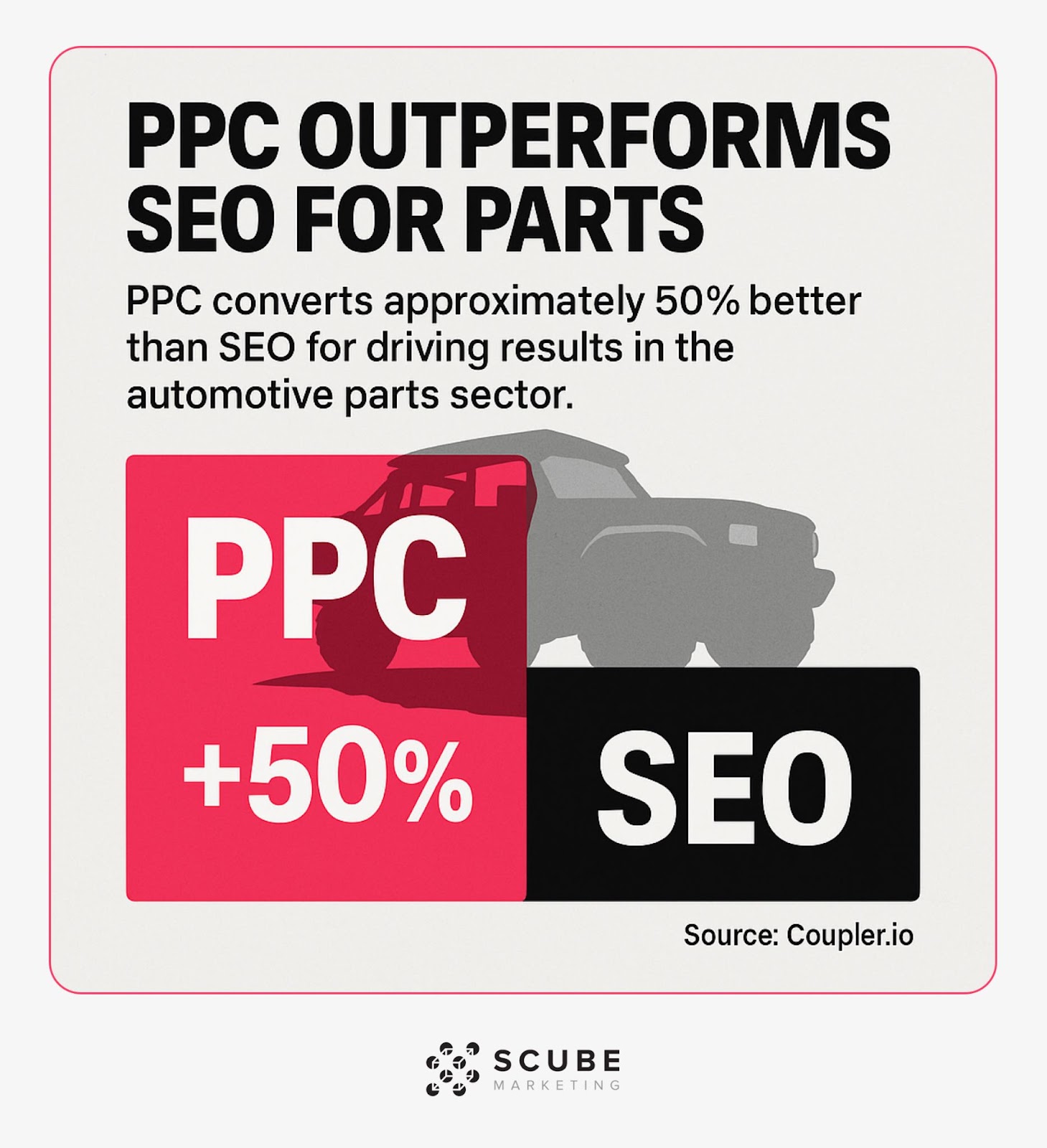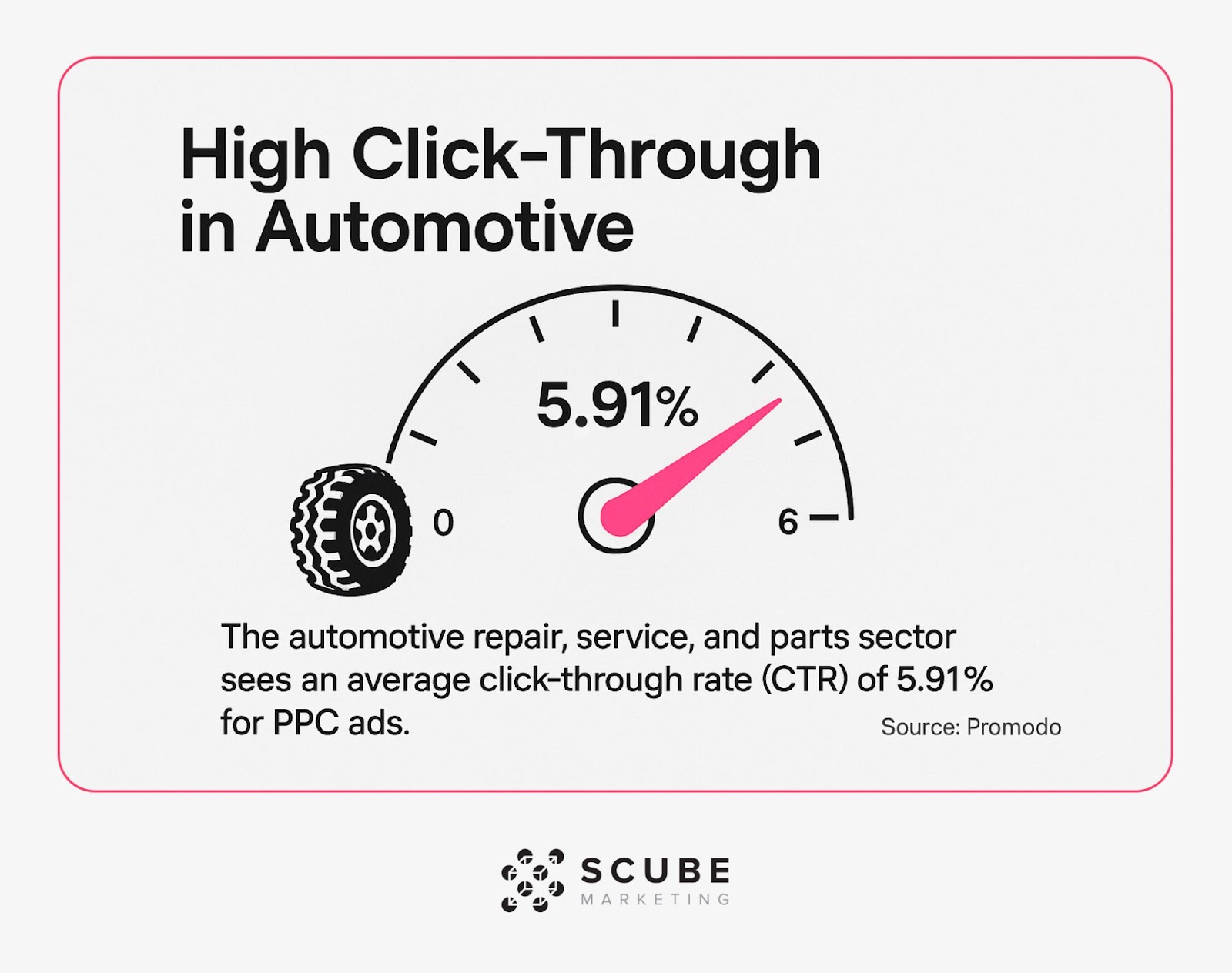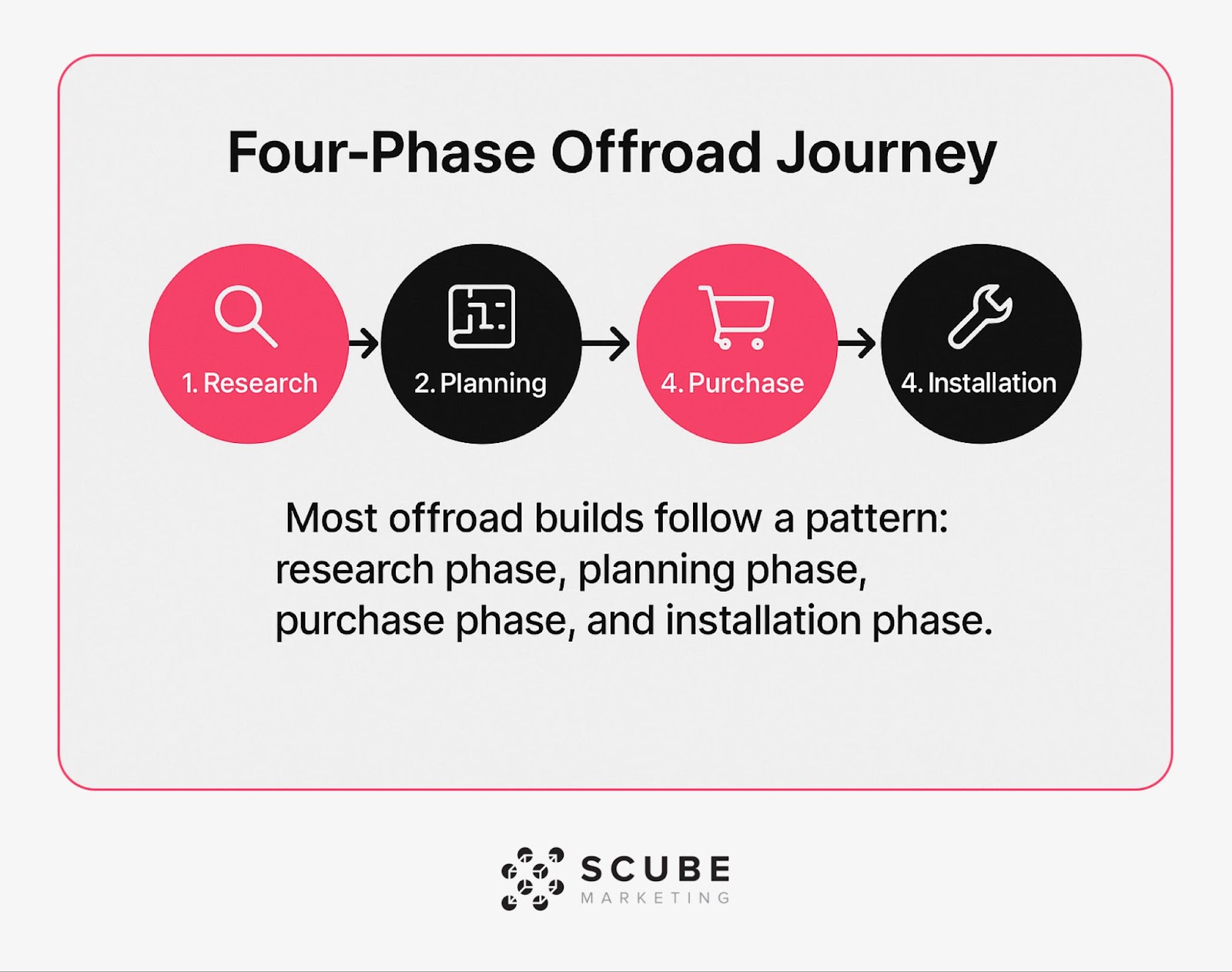
The offroad parts market is a beast of its own. I've spent years helping aftermarket automotive businesses connect with customers through PPC advertising, and there's something unique about the offroad segment. These enthusiasts aren't casual shoppers—they're passionate researchers who know exactly what they want for their rigs.
When someone searches for "Fox shocks for a 2023 Tacoma TRD" or "steel bumper with winch mount for Bronco," they're not just browsing. They're hunting for specific components to enhance their vehicle's capability and appearance. This high-intent behavior makes PPC advertising particularly effective for offroad parts retailers.

Data confirms this advantage. PPC converts approximately 50% better than SEO for driving results in the automotive parts sector. (Source: Coupler.io)
In this guide, I'll share the strategies I've found most effective for marketing suspension components, offroad tires, and protective armor through PPC campaigns. Let's get your products in front of the right offroad enthusiasts at the moment they're ready to buy.
Offroad enthusiasts are a different breed of customer. They research extensively before purchasing and often have very specific requirements for their vehicle builds. This behavior shapes how we should approach PPC for these products.

The numbers tell an interesting story. The automotive repair, service, and parts sector sees an average click-through rate (CTR) of 5.91% for PPC ads. (Source: Promodo)
This CTR is impressive compared to many other industries. Offroad parts shoppers actively click on relevant ads during their research process. They're looking for detailed information, compatibility confirmation, and the best deals on quality components.

Understanding this customer journey helps us create more effective campaigns. Most offroad builds follow a pattern:
Your PPC strategy should address each of these phases with specific messaging. Someone in the research phase needs detailed specifications and comparisons, while a buyer in the purchase phase needs to see pricing, shipping information, and availability.
Before diving into specific strategies, let's examine the current PPC benchmarks for the automotive aftermarket industry. These figures provide a baseline for setting expectations and measuring performance.
|
Metric
|
Value |
Industry Context
|
|---|---|---|
|
Average CTR
|
5.91%
|
Higher than general eCommerce average
|
|
Average CPC
|
$3.39
|
Moderate compared to other specialty industries
|
|
Average Conversion Rate
|
12.61%
|
Significantly higher than typical eCommerce
|
|
Average Cost Per Lead
|
$27.94
|
Reasonable for high-value purchases
|
These benchmarks show why PPC is particularly effective for offroad parts retailers. The high conversion rate indicates that when you get the targeting right, customers are ready to purchase.
Not all advertising platforms perform equally for offroad components. Your choice of platform should match both your product category and your target audience's shopping behavior.
I've found that a multi-platform approach works best for most offroad parts retailers. Each platform serves a specific purpose in the customer journey.
Here's how the major platforms compare for marketing different offroad component categories:
|
Platform
|
Best For
|
Key Advantage
|
Ideal Product Types
|
|---|---|---|---|
|
Google Search
|
High-intent shoppers
|
Capturing active product searches
|
All technical components
|
|
Google Shopping
|
Visual product comparison
|
Showcasing product images with pricing
|
Visually distinctive items (bumpers, wheels)
|
|
Facebook/Instagram
|
Brand awareness
|
Targeting based on vehicle interests
|
Visually appealing armor, aesthetic upgrades
|
| YouTube |
Educational content
|
Demonstration of installation/performance
|
Complex suspension systems, technical products
|
For most offroad parts retailers, I recommend allocating the largest portion of your budget to Google Search and Shopping. These platforms capture high-intent traffic from users actively looking for specific components.
For offroad parts, social platforms like Facebook and Instagram work best as supplementary channels. They're excellent for building awareness and targeting enthusiasts based on their vehicle interests, but typically have lower direct conversion rates than search advertising.
Suspension components represent some of the most technical products in the offroad market. From lift kits to specialized shocks, coilovers to control arms, these products require detailed knowledge and precise vehicle fitment.
This technical nature makes them perfect for targeted PPC campaigns. Buyers searching for suspension components typically know exactly what they need and have specific requirements.
When creating campaigns for suspension products, focus on these key elements:
The keyword strategy for suspension products should prioritize specificity over volume. Rather than bidding on broad terms like "lift kit" (which would be prohibitively expensive), target specific phrases like "4-inch lift kit for 2022 Jeep Wrangler Rubicon" to reach buyers with high purchase intent.
Here's a comparison of keyword strategies for different suspension product categories:
|
Product Type
|
Keyword Strategy
|
Example Keywords
|
Bidding Approach
|
|---|---|---|---|
|
Lift Kits
|
Vehicle + Height Specific
|
"2.5 inch lift kit F150 4x4"
|
Aggressive on exact match
|
|
Performance Shocks
|
Brand + Vehicle Focused
|
"Fox shocks Tacoma TRD Pro"
|
Moderate on phrase match
|
|
Control Arms
|
Problem-Solution Based
|
"adjustable control arms for lifted Jeep"
|
Conservative on broad match |
|
Coilover Systems
|
Performance + Vehicle
|
"off-road racing coilovers Ford Bronco"
|
Aggressive on phrase match
|
For ad copy, focus on technical accuracy and compatibility assurance. Suspension buyers worry most about whether components will fit their specific vehicle and installation complexity. Address these concerns directly in your ads.
Wondering what makes effective aftermarket auto parts eCommerce PPC campaigns in 2025? For suspension products, it's the combination of technical specificity and clear compatibility information that converts browsers into buyers.
Tires represent one of the most competitive segments in the offroad parts market. Major manufacturers and large retailers allocate significant budgets to tire advertising, making it challenging for smaller retailers to compete on broad terms.
Success in this space requires a specialized approach. I've found that the most effective tire PPC campaigns focus on specific niches and customer needs rather than trying to compete head-on with major retailers.
The offroad tire market breaks down into several sub-categories, each requiring a different PPC approach:
|
Tire Category
|
Target Audience
|
Key Selling Points
|
PPC Strategy Focus
|
|---|---|---|---|
|
All-Terrain
|
Daily drivers with occasional offroad use
|
On-road comfort with offroad capability
|
Balanced messaging, focus on versatility
|
|
Mud-Terrain
|
Serious offroad enthusiasts
|
Maximum traction in challenging conditions
|
Performance-focused, terrain specificity
|
|
Rock Crawling
|
Technical offroad specialists
|
Sidewall strength, grip on rock surfaces
|
Technical specifications, durability emphasis
|
|
Snow/Winter
|
Adventure vehicles in cold climates
|
Winter performance, ice traction
|
Seasonal targeting, geographic focus
|
For tire campaigns, I recommend these specialized PPC tactics:
Ad extensions are particularly valuable for tire campaigns. Price extensions can showcase different size options, while structured snippets can highlight key features like sidewall reinforcement or special compounds.
For a deeper dive into effectively structuring your campaigns, check out our guide on eCommerce PPC management strategies that works especially well for automotive parts retailers.
Armor and protection components—including bumpers, skid plates, rock sliders, and undercarriage protection—present unique opportunities in PPC advertising. These products benefit from their visual appeal and specific applications.
Unlike more technical components like suspension parts, armor and protection products sell on both functional benefits and aesthetic appeal. This dual nature influences how we approach PPC for these items.
With the aftermarket parts industry growing significantly each year, competition for customer attention in the armor category continues to intensify. Standing out requires a specialized approach.
The most effective platform mix for armor products differs from other offroad categories:
|
Platform
|
Effectiveness for Armor
|
Best Content Approach
|
Key Metrics to Watch
|
|---|---|---|---|
|
Google Search
|
High
|
Technical specifications, vehicle fitment
|
Conversion rate, ROAS
|
|
Google Shopping
|
Very High
|
High-quality product images from multiple angles
|
CTR, conversion rate
|
|
Instagram
|
Excellent
|
Installed product photos, before/after transformations
|
Engagement rate, click-through
|
|
YouTube
|
Good
|
Installation guides, product testing/demos
|
View-through conversions
|
For armor products, these PPC approaches yield the best results:
The visual nature of these products means that Google Shopping and social media platforms often outperform standard text ads. Invest in high-quality photography (and see our tips for high-quality photography for aftermarket auto parts) showing products both individually and installed on vehicles.
Remarketing is particularly effective for armor products due to their higher price point and visual appeal. Customers often research these items extensively before purchasing, making them perfect candidates for strategic remarketing campaigns.
Proper budget management is critical for offroad parts PPC success. The automotive parts industry sees an average cost per click (CPC) of $3.39 and an average cost per lead (CPL) of $27.94. (Source: Promodo)
These figures provide a baseline, but I've found that costs can vary significantly based on product category, competition level, and targeting approach. Offroad suspension terms tend to be less expensive than tire-related keywords, while some armor and accessory terms fall somewhere in between.
Here's a model for budget allocation across different campaign types for an offroad parts retailer:
|
Campaign Type
|
Recommended Budget %
|
Expected ROAS
|
Performance Indicators
|
|---|---|---|---|
|
Brand Terms
|
15-20%
|
800-1000%
|
High conversion rate, low CPC
|
|
Product/Category Terms
|
30-40%
|
400-600%
|
Moderate conversion rate, medium CPC
|
|
Google Shopping
|
20-25%
|
500-700%
|
Good CTR, visual engagement
|
|
Remarketing
|
10-15%
|
900-1200%
|
High conversion rate, lower CPC
|
|
Testing/Expansion
|
5-10%
|
Varies
|
Learning and optimization
|
This allocation framework gives you a starting point, but you should adjust based on performance data from your campaigns. Some businesses find greater success with a heavier focus on Shopping ads, while others see better returns from search campaigns.
For measuring ROI, look beyond simple ROAS calculations. Most impressively, the auto parts industry achieves an average conversion rate of 12.61% for PPC campaigns, significantly higher than many other eCommerce sectors. (Source: Adthena)
This high conversion rate means that properly targeted campaigns can deliver exceptional returns. Track not just immediate sales but also:
Adjust your budget allocation quarterly based on performance data, but review campaigns weekly to make tactical optimizations. Offroad parts shopping has strong seasonal patterns that should influence your budget distribution throughout the year.
Once you've established your core campaigns, these advanced tactics can help you gain a competitive edge in the offroad parts market. These approaches require more sophisticated setup but can deliver exceptional results.
To show how competitive this market is, consider that the top 10 auto parts retailers account for 67.85% of PPC clicks (Source: Adthena). That leaves around 32% of clicks for the rest of the parts market.
To compete effectively, smaller retailers need to be smarter with their campaigns. Here are advanced tactics that can help:
Create dynamic search campaigns that automatically adjust to the specific vehicle a customer owns. This approach requires some technical setup but delivers highly relevant ads.
The process works by:
For example, someone searching for "Jeep JK lift kit" would see dynamically generated ads featuring your compatible lift kit products specifically for the JK platform.
Rather than showing the same remarketing ads repeatedly, create a sequence that guides potential customers through the buying journey:
|
Remarketing Stage
|
Days Since Visit
|
Message Focus
|
Call to Action
|
|---|---|---|---|
|
Initial Awareness
|
1-3
|
Product features and benefits
|
"Learn More"
|
|
Consideration
|
4-7
|
Technical details, compatibility
|
"See Specifications"
|
|
Evaluation
|
8-14
|
Reviews, testimonials, performance
|
"Read Reviews"
|
|
Decision
|
15-30
|
Special offers, guarantees
|
"Buy Now" with incentive
|
This approach recognizes that offroad part purchases often involve extended consideration periods. Your messaging should evolve as the customer progresses through their research journey.
Strategic competitor targeting can help you capture market share, but it requires careful implementation to be cost-effective. Rather than bidding directly on competitor brand names (which can be expensive), focus on terms that indicate comparison shopping:
Proper inventory management for auto parts is crucial for all these advanced campaigns. Nothing frustrates customers more than clicking on an ad only to find the product out of stock or incompatible with their vehicle.
Effective PPC for offroad suspension, tires, and armor requires specialized knowledge and strategic implementation. The unique nature of this market—with its technical products and highly engaged customers—creates both challenges and opportunities.
Success comes from understanding the distinct needs of each product category:
For suspension components: Focus on technical accuracy, vehicle compatibility, and performance benefits. Leverage specific long-tail keywords that match exact vehicle applications.
For offroad tires: Emphasize terrain specialization, size availability, and performance characteristics. Use visual platforms to showcase tread patterns and real-world applications.
For armor and protection: Balance functional benefits with aesthetic appeal. Leverage image-focused advertising and highlight both protection capabilities and visual transformation.
Across all categories, remember that 84% of marketers report achieving good results with PPC campaigns when properly optimized for their specific industry. (Source: Coupler.io)
Start with the foundations outlined in this guide, then test and refine your approach based on your specific product mix and customer base. The most successful offroad parts retailers treat PPC as an ongoing optimization process rather than a set-it-and-forget-it tactic.
What PPC strategies have worked best for your offroad parts business? I'd love to hear about your experiences in the comments below.
Our customers value boutique agency approach with access to a seasoned team, profit-based goals, and clear communication.



